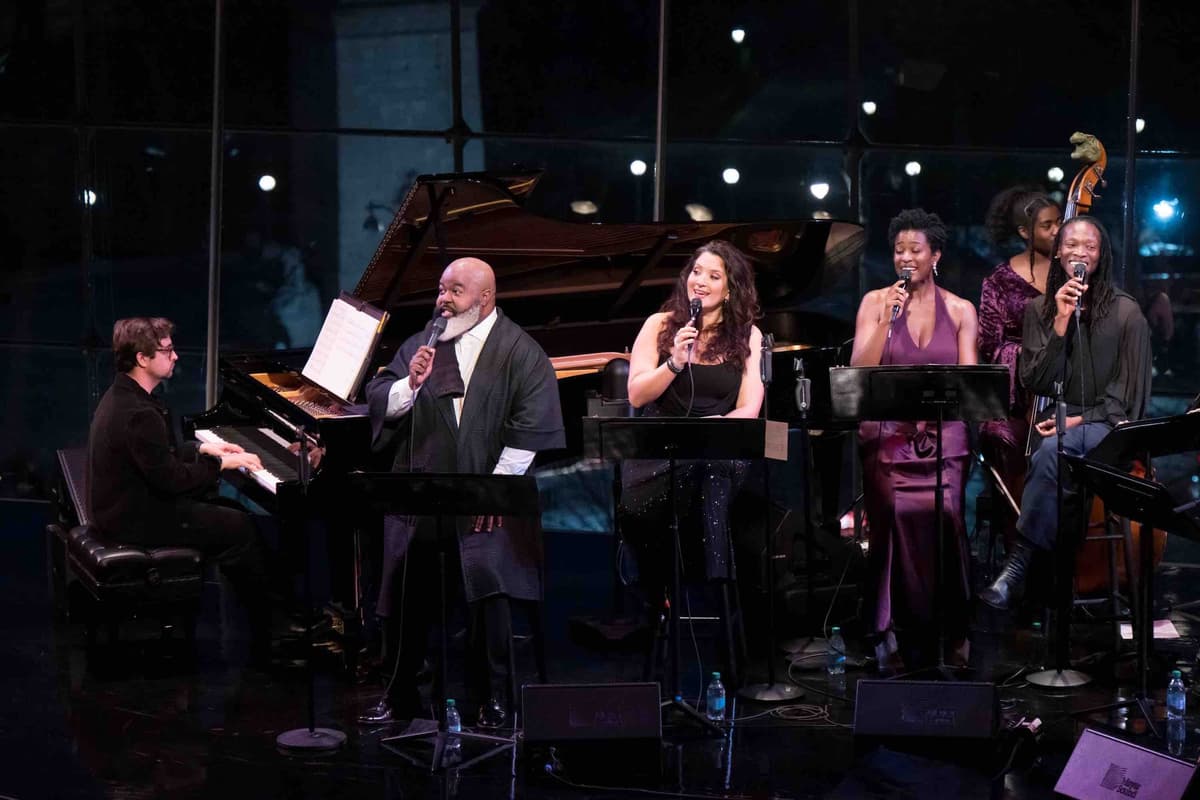An Album Unlike Most Anything in Annals of Jazz or Musical Theater, ‘The Real Ambassadors’ Gets New Life
In the 1950s Dave and Iola Brubeck had the idea of creating a Broadway musical about the jazz experience starring Louis Armstrong. The music was just performed at Jazz at Lincoln Center.

‘The Real Ambassadors’
Sony Music Legacy
‘The Complete Louis Armstrong Columbia and RCA Victor Studio Sessions 1946-1966’
Mosaic Records
‘The Real Ambassadors: Armstrong and Brubeck’
Jazz at Lincoln Center
Streaming Through April 12
It was about 1958 that one of the foremost pianists/composers/bandleaders on the contemporary music scene, Dave Brubeck, and his wife, the poet and lyricist Iola Brubeck, had the idea of creating a Broadway musical about the jazz experience. Specifically, it was going to be about Louis Armstrong, and the plan was that it would star the man himself.
The result never made it to the Great White Way, but it was performed live at the Monterey Jazz Festival in 1962. In 1961, it had been recorded by Columbia Records with an all-star cast led by Armstrong and including a legendary jazz singer, Carmen McRae, and the greatest jazz vocal group of the modern era: Dave Lambert, Jon Hendricks, and Annie Ross.
That album, “The Real Ambassadors,” is unlike pretty much anything in the annals of either jazz or musical theater. More recently, it’s been made available in an expanded form as part of a Mosaic boxed set, and there has also been a book published on the project, Keith Hatschek’s “The Real Ambassadors: Dave and Iola Brubeck and Louis Armstrong Challenge Segregation.” This past weekend, the work was performed over four shows at Jazz at Lincoln Center; they are available to livestream through Saturday.
“The Real Ambassadors,” both in 1962 and 2025, was performed, not as a full-blown musical comedy but in a concert format, with a full cast of six musicians, one doubling on vocals, and four singers. In between the songs, the script was summarized in the form of narration read by Daniel J. Watts.
Drummer Jake Goldbas and pianist Chris Pattinshall served as director and musical director, respectively, and the rest of the band was made up of bassist Caylen Bryant, saxophonist-singer Camille Thurman, trumpeter Alphonso Horne, and trombonist Chris Brubeck, the son of the creators. Shenel Johns, the excellent South African baritone Vuyo Sotashe, and Grammy winner Nicole Zuraitis served as the vocal ensemble, and C. Anthony Bryant took the starring role. Mr. Bryant was an out-of-the-box brilliant choice.
“Ambassadors” is one of my favorite later Armstrong albums because his singing is so mellow and ripe; here, he croons in a remarkable, deep basso that’s almost reminiscent of Paul Robeson, especially on “Summer Song,” one of his most poignant vocals ever. Mr. Bryant sings in a much higher tenor, but he comes through with a style of his own that’s warm and engaging, interpreting the work on his own terms rather than just being a faux-Satchmo. He has all the charm and sweetness of a great big pussycat with two-toned whiskers.
I will be surprised if this past weekend isn’t a major feather in the cap of Mr. Bryant, and likewise for the outstanding Shenel Johns, who divided up the three major songs written for McRae with the other two female singers. Ms. Zuraitis was outstandingly Carmen-like on “Good Reviews,” as was Ms. Thurman on “My One Bad Habit,” but the young Ms. Johns is really coming into her own on numbers like “In the Lurch.” As a trio, Mr. Sotashe, and Ms. Johns and Ms. Zuraitis did such an outstanding job recreating Lambert, Hendricks, and Ross that I wish they would next tackle the entire “Sing a Song of Basie” album.
“Real Ambassadors” is, at the very least, an outstanding collection of songs, though the Brubecks apparently had not intended to come up with what we would call a song cycle. They wrote a script in which Armstrong is presented as a real musician with a real band but in a fictitious dramatic situation — sort of anticipating the Beatles in “Help!” in 1965.
Armstrong himself was very proud of his involvement, and was quoted as saying that it “was five years ahead of its time and the big shots that buy shows for Broadway were afraid of it.” Making the work even more toxic for comparatively conservative Broadway backers was that some of the lyrics tackled social justice issues, with lines like, “Oh, we learned to be concerned about the constitutionality / In our nation, segregation isn’t a legality.”
Alas, that simply was not true in 1962, when Jim Crow laws were still enforced in most of the country.
Iola Brubeck deserves a lot of credit; her lyrics here are excellent. As in the two albums that the classic Brubeck Quartet with Paul Desmond recorded with Carmen McRae, she does a remarkable job of translating her husband’s melodic ideals into verse. Alas, the overall dramatic arc of the work is simlply not up to the music and words; this has to be a song cycle just because it couldn’t possibly work as full-blown musical theater.
The story, with Satchmo being mistaken for an actual U.S. ambassador and simultaneously having a romantic relationship with his band’s female singer, is as paper-thin as any lesser Hollywood musical in which Armstrong ever appeared. Why, for instance, does the story begin with Armstrong imagining himself as a desert sheik in “Nomad”? The song itself is marvelous — the melody anticipates a 1966 French movie theme hit, “A Man and a Woman” — but there’s no dramatic hook upon which to hang it.
In the early ’60s, there were several attempts by jazz-based songwriters to come up with a larger narrative work in the jazz idiom, including Jon Hendricks’s “Evolution of the Blues” (1960) and Duke Ellington’s “My People” (1964). In 1965, though, Ellington licked the problem with his first of three “Concerts of Sacred Music.” You could present a jazz orchestra and a cast of singers plus a choir in a program of connected songs, but, as Ellington realized, expecting it to bear the weight of narrative was asking too much. No wonder that the Ellington “Sacred” concerts have been heard from much more than these other works.
“The Real Ambassadors” doesn’t need the narrative framework, and is almost better off without it. Having said that, though, this is a delightful and highly worthy, unique work that deserves to be performed in concert halls all over the world. It’s particularly welcome at this bleak moment when America is provoking anger and hostility across the globe — and, frankly, needs all the help it can get.

